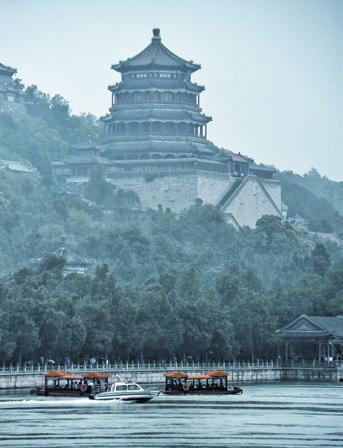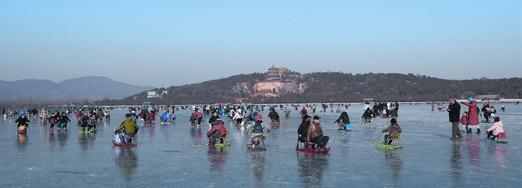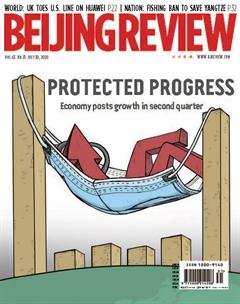Last Green Masterpiece
By Li Qing

When Beijing Television Station started a new cultural variety show, I Will Wait for You in the Summer Palace—on July 3, it brought cheer to many people who have not traveled for a long time. It gave them not only an online tour of a beautiful destination with breathtaking scenery but also brought to light its culture, history and philosophy.
The destination: the Summer Palace, the famed imperial garden in northwest Beijing, built during the Qing Dynasty (1644-1911) and included in the UNESCO World Heritage List in 1998.
The historical site has been given modernday glamor by actors and other celebrities who are the guides during the virtual sightseeing tour, telling the audience about the history of its attractions. They also play games featuring the palace and the historical personages associated with it, occasionally introducing new cultural products.
The first episode featured the Tower of the Fragrance of the Buddha, which offers one of the best views of the entire garden, and the Long Corridor, a covered walkway over 700 meters long with its beams adorned with more than 8,000 colorful paintings depicting stories from Chinese classics and folktales.
“This is my favorite kind of TV program where I can learn things accompanied by beautiful pictures,” a viewer, Yang Yang from Nanjing in east China, told Beijing Review. She had visited the garden in 2018 but decided to go again after it was reopened in March following a closure due to the novel coronavirus outbreak.
Essential study
The Summer Palace is a favorite subject of scholars due to the people associated with it and events, Zhao Di, an associate professor of Tianjin University, told Beijing Review. “The history of its construction and surrounding area is essential reference research material for studying classical Chinese gardens, the development of Beijing and even the country,” she said.
In 1744, Emperor Qianlong finished expanding in northwest Beijing a luxury imperial garden, known as the garden of gardens. Because of the enormous cost, the emperor, who ruled over a prosperous and cosmopolitan empire that accounted for nearly 25 percent of the worlds wealth, decided not to build any more new gardens.
However, six years later, a new imperial garden, the Summer Palace, the last royal garden in Chinese history, began to be built to celebrate the queen mothers birthday and improve water conservancy in the suburbs. The emperor designed the garden with its temples and pavilions, focusing on maintaining harmony with nature.
According to a documentary by China Central Television, the emperor set himself a rule as punishment for breaking his pledge not to build any more new gardens. He would arrive at the Summer Palace early in the morning and return before noon, never spending a night there, which meant he never saw its beauty at night.
The garden was devastated by Western invaders in 1860 but reconstructed as a summer retreat for the Empress Dowager Cixi(1835-1908). Today, the resort, fl anked by the Longevity Hill and Kunming Lake, sprawls over 3.08 square km, three quarters of which is under water.
Traditional connotations
Emperor Qianlong had a deep fascination with Jiangnan, the middle and lower reaches of the Yangtze River, renowned for its exquisite classical gardens. He made six tours to the region, which provided many elements of design for his new resort.

“The Summer Palace combines the style and features in the West Lake area in Hangzhou, Zhejiang Province in east China, and classical gardens in Jiangnan, not only in the landscape but also in the architectural layout,” Zhao said. “It combines natural elements such as mountains, river, lakes and plants with buildings and also expresses the creative art of Chinese landscape garden designs.”
The Summer Palace has maintained a balance between ecological conservation and construction. Since the Ming Dynasty (1368-1644), the suburbs in northwest Beijing were the first choice for the royals and nobility to build gardens. Along with the Qing Dynastys development, the number of gardens in the area increased dramatically, causing massive water shortage. The Summer Palace uses water conservation methods. Its construction has improved the water quality of the lake inside and greened the Longevity Hill, optimizing the ecological environment.
A number of temples and monasteries on the Longevity Hill met the spiritual needs of the royal family and provided accommodation for religious leaders when they came to Beijing to present themselves in the royal court.
Bringing history to life
The government has reinforced the protection of the Summer Palace. Conservation and landscape maintenance have been carried out using traditional techniques and appropriate materials to ensure the authenticity of the historical landmark.
Today, variety shows rooted in top-tier scenic spots, including the Palace Museum and the Great Wall, have become a popular trend. Zhao said this kind of program should be careful to show respect for culture.
Besides the innovative games in the variety show, another segment Yang awaits eagerly is where cultural products are introduced.
“I loved the clothes in the fi rst episode,” she said. “Embroidered to show the resorts landscape, the blue garments looked like an elegant landscape painting,” she said.
“To pass on Chinese culture, it is far from enough to rely only on such programs. Our task is to create a platform for young people to infl uence their peers,” Ma Hong, a member of the variety program, told Xinhua News Agency.
“Mainstream TV stations can help viewers build cultural confi dence and encourage them to learn our culture and history with the support of Internet platforms, utilizing their social education function,” Zhao said.


